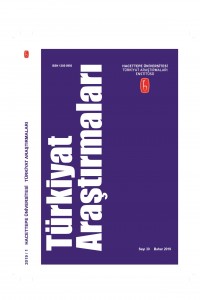Öz
The
article presents our reading and interpretation of a recently discovered
runiform inscription, which was found on the petroglyphic site Sarykoby in the
South-Eastern Altai. This small petroglyphic site is located on the northern
spurs of the Saylugem ridge stretching in the Chuya steppe.
The
inscription consists of two lines and is a part of a large petroglyphic
composition with extraordinary images. Its lines contain 21 and 13 characters
respectively. The proposed translation with two different variants of the
second line sounds as follows: “I have written on the rock, ah! Oh, please
speak! Giving good fortune (Or ‘Having gone to battle’) ‒ oh ‒ I have written
(it)." M. Erdal considers several variants of translation of the same
words and proposes the most preferable ones. In addition, he concludes that the
word su / sü – “glory, imperial fortune, majesty, happiness”, which is
represented in the Sarykoby inscription, belongs to one of the few early Mongolian
loans in the Old Uygur language and, possibly, in Old Turkic.
The
inscription of Sarykoby is carved superficially, with small signs and in a
hidden place; it was clearly not intended for everybody’s attention and
reading. This confirms the opinion of many scholars about the personal nature
of the most Altai runiform inscriptions. At the same time, it invites readers
to a dialogue and, maybe, contains a call for a prayer or a blessing.
The
inscription is clearly readable but still quite enigmatic, apparently featuring
an early Mongolic loan. Its content, unlike that of the epitaphs, visitors’
inscriptions and others discovered in the Russian Altai, can be defined as
religious-philosophical. The person who wrote the Sarykoby inscription might
have believed in its ability to pass on his blessing to those who would read
it. This determines its originality and significance in the Altai corpus of
runic inscriptions.
Anahtar Kelimeler
the translation and interpretation of runiform inscriptions Altai Republic South-Eastern Altai region
Kaynakça
- Erdal M. (1998) Eine unbekannte Jenissei-Inschrift aus der Adrianov-Kollektion. J.-P. Laut ve M. Ölmez (yayınl.), Bahşı Ögdisi: Festschrift für Klaus Röhrborn anläßlich seines 60. Geburtstags, Freiburg–Istanbul: Simurg, s. 83–96.
Öz
Bu makalede Güneydoğu Altay’da bulunan
Sarı-Kobı kaya resimleri arasında yeni keşfedilen Eski Türk runik harfli bir
yazıt tanıtılmakta, yazarların yazıtla ilgili okuma önerileri ve yorumları yer
almaktadır. Söz konusu petroglif sitesi Çuy bozkırı boyunca uzanan Saylu-Kem (Rusça
kaynaklarda Сайлугем) dağ silsilesinin kuzey yamaçlarında bulunmaktadır.
Sıra dışı imgeleri olan büyük bir
petroglifik kompozisyonun bir parçası olan yazıt iki satırdan oluşmaktadır. İlkinde 21, ikincisinde ise
13 işaret vardır. İkinci satırıyla ilgili iki farklı okuyuş önerisi bulunan
yazıtın çevirisi şöyledir: “Kayaya yazdım, eh! Lütfen, konuş! Talih bahşedip (veya
Savaşa giderken), eh, (bunu ben) yazdım (bunu”. Yazıtla ilgili yorumlarında
M. Erdal aynı sözcüklerin farklı yorumlanabileceği üzerinde durmakla birlikte onlardan
en uygun olanı üzerinde karar kılmaktadır. Kendisi ayrıca Sarı-Kobı yazıtında
geçen su/sü “ün, imparatorluk şanı, haşmet, saadet” sözcüğünün
Eski Uygurca ve muhtemelen Türk runik yazılı metinlerin dilinde de geçen az
sayıdaki erken Moğolca ödünçlemelerden biri olduğu sonucuna varmıştır.
Sarı-Kobı yazıtı taş üzerindeki
kuytu bir yere, küçük harflerle yüzeysel olarak hakkedilmiştir; görünüşe göre herkesin
onu görüp okuması istenmemiş olsa gerek. Bununla birlikte yazıt okuyucuyu
diyaloga, belki de ibadete veya duaya davet etmektedir. Genel olarak, yazıtın
açıkça okunabilir olduğunu, ancak hâlâ gizemini koruduğunu ve görünüşe göre Ana
Moğolcadan ödünçleme içerdiğini belirtebiliriz.
Yazıtın içeriğinin, Eski Türk
yazıtlarının çoğundan farklı olarak ruhani veya felsefi tipten olduğu
söylenebilir. Sarı-Kobı yazıtını hakkeden kimsenin hayır duasının yazdığını
okuyan kişiler tarafından kabul göreceğine inanan biri olduğu görünüyor; bu da
söz konusu yazıtın Eski Türk yazıtları arasındaki özgünlüğünü ve önemini
belirler niteliktedir.
Anahtar Kelimeler
Eski Türk yazıtları Altay Cumhuriyeti güneydoğu Altay yöresi Eski Türkçe
Kaynakça
- Erdal M. (1998) Eine unbekannte Jenissei-Inschrift aus der Adrianov-Kollektion. J.-P. Laut ve M. Ölmez (yayınl.), Bahşı Ögdisi: Festschrift für Klaus Röhrborn anläßlich seines 60. Geburtstags, Freiburg–Istanbul: Simurg, s. 83–96.
Ayrıntılar
| Birincil Dil | Türkçe |
|---|---|
| Bölüm | Çeviri ve Değerlendirmeler |
| Yazarlar | |
| Çevirmenler |
Rysbek Alimov Bu kişi benim |
| Yayımlanma Tarihi | 6 Temmuz 2019 |
| Gönderilme Tarihi | 7 Mayıs 2019 |
| Yayımlandığı Sayı | Yıl 2019 Sayı: 30 |


